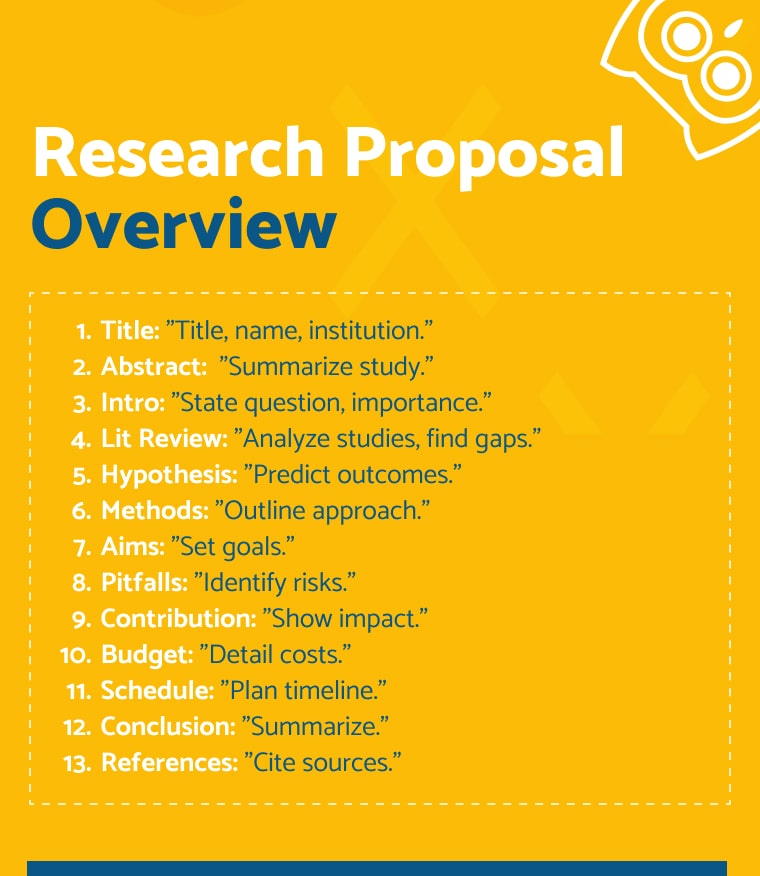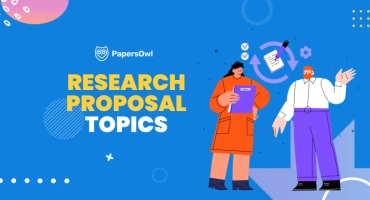How to Write a Research Proposal?
Table of contents
A good research proposal aims to outline the whole research project. Whether you make it for a class assignment or a thesis, they must be compelling and well-structured.
This guide will walk you through each section of an established research proposal. We’ll offer tips on convincing the audience of the importance of your paper. Ultimately, you’ll be able to present ideas clearly and concisely.
If the research itself is too demanding to complete after the proposal is approved, many students choose to hire an expert to do my research paper professionally.
The Main Paper Requirements
The academic writing proposal must convince the evaluation committee that the existing research design is credible, achievable, and reproducible. Committees often include academic colleagues, policy-makers, practitioners, and lay audiences, each with different expectations.
How to write a research proposal? Follow these simple steps:
- Be practical and persuasive;
- Make broader connections;
- Aim for clarity;
- Plan before you write.
As the researcher, you should understand what can be achieved and how to convince others. Thus, state your study aims simply, avoiding jargon. Non-specialists must also be familiar with the research proposal’s aims.
In the end, your research proposal should reflect:
- How your work fits into existing knowledge;
- The new literature perspectives;
- The research question, its significance, and the implications.

Title Page
The first thing readers will see is your research proposal’s title page. It should focus on the research topic, briefly capturing your study’s essence. Include your name, the date, and the affiliated institution beneath the title.
A well-thought-out title does more than just summarize the topic — it sets the tone for the entire proposal. This is the main reflection of your study. The title page should be specific enough to convey the proposed research focus. On the contrary, it has to be broad enough to capture the overall scope of your work.
Additionally, a strong title intrigues the reader, encouraging them to challenge existing theories. The relevant keywords also make it easier to reference you for future research. Think about how the title will appear in academic databases or other search engines. It affects how the broader audience will perceive your research proposal’s argument.
Abstract
The abstract is the first substantive part of your research proposal. It should be concise yet comprehensive enough to give a clear snapshot of your entire project. If you make it ChatGPT generated, ensure the abstract maintains a professional tone. The abstract size for a research proposal varies between 150 and 250 words.
It should review:
- The problem you’re addressing;
- The research objectives;
- The expected outcomes.
Although it comes first in the document, writing the abstract last is easier. Once you’ve detailed the main research methods, you’ll feel comfortable summarizing them.
Introduction
The introduction of your research proposal provides the essential study context. This section explains the background of your research and its significance. It also lays the groundwork for the research methodology. Here, you’ll outline the main research question that your study aims to address. Make sure you give the reader a clear understanding of the problem.
This section must convey the importance of your research. An introduction does not only explain your research but also why it matters. By the end of this section, the reader should feel confident that your study is both relevant and necessary.
Before writing the introduction, consider the deeper context of your research proposal. Ask yourself: Does this study respond to a gap after a thorough literature review? Does it address a new development in the field or tackle a pressing issue? The context will help you articulate the necessity of your data analysis and its potential impact.
Take a look at these simple tips to make an informative introduction:
- Be clear about how your study will contribute to existing knowledge;
- Highlight the potential value of your data analysis;
- Convince the reader that your research is essential to the whole field;
- Remember who you are writing for. Tailor the introduction to the level of expertise your audience has. Whether it’s academic peers, potential funders, or policy-makers, ensure that your introduction speaks to their concerns.
Literature Review
The literature review summarizes and analyzes previous research related to your topic. It is a critical part of a research proposal, where you demonstrate the current state of studies and find the gaps to fill.
There’s a rule of 5 C’s to get started with your literature review.
| Citing | Choose the appropriate sources for your research problem. |
| Comparing | Take time to look through arguments, theories, and findings expressed in literature. Explain how they are similar and why they matter to your topic. |
| Contrasting | Browse for controversy in literature findings. Analyze those differences and explain how they impact an outcome. |
| Critiquing | It’s time for your voice! Describe the more persuasive arguments, and make sure you explain your decision. |
| Connecting | Synthesize your field of research and the literature findings. How do they connect, and why should readers pay attention? |
As you compile your literature review, focus on relevant case analysis and research topics, depending on your audience. Highlight key academic findings and discuss how your research will challenge them. Taking ideas from existing literature can frame your study for a broader academic conversation.
Hypothesis
This section presumes to discuss the expected outcomes of your research. A hypothesis is a testable prediction that arises from your literature review. It should be specific, measurable, and relate to your research question.
When working on this section, align it with the main study objectives. You might rather set research questions than a formal hypothesis if you conduct exploratory research. This section is critical for guiding your research design and methods.
Research Design and Methods
In this part, outline your research approach (e.g., qualitative, quantitative, or mixed methods), data collection methods (e.g., surveys, interviews, experiments), and analysis techniques.
The research design section has to convince reviewers that your study is feasible and methodologically sound. Therefore, you should describe your research methodology in detail. For instance, explain why this method is appropriate if your study involves a case analysis.
Ensure you consider ethical implications, particularly if your research involves human subjects. For ethics paper topics, take extra space to discuss your approach to the study.
Specific Aims
These aims are not just for the reader. They play a huge role in keeping your study on track. You stay focused and organized by clearly defining your research ambitions. It’s very important if your research proposal involves complex topics. Specific goals, in this case, prevent you from becoming sidetracked.
If you’re looking for good research proposal ideas, start by identifying manageable aspects of your topic. Focus on goals that are significant yet feasible within the project’s timeframe This approach not only makes your academic writing more realistic but also increases the likelihood of producing meaningful results.
Specific aims aligned with your overall research objectives will strengthen your research proposal. Plus, they will show reviewers that you have a clear and actionable plan. Each aim should concisely describe what you intend to accomplish through data analysis.
When drafting this section, ensure that the specific aims are achievable within the project’s scope. Think of them as small steps toward your main research question.
Potential Pitfalls and Alternative Strategies
There’s no project without a risk. In this section, you’ll identify potential challenges that could arise during your study. You also have to propose working strategies to overcome them. This will demonstrate your ability to anticipate problems and adapt your research plan if necessary.
Potential pitfalls of a research proposal include:
- Data collection issues;
- Unexpected results;
- Ethical concerns.
Acknowledging these risks will show readers you have a well-thought-out plan for managing uncertainties in your research.
Contribution to Knowledge
This section of your research proposal highlights the potential impact of your study. Explain how your research will contribute to the existing body of knowledge. Use either a literature gap or a practical issue to introduce a fresh perspective.
When discussing relevance, connect it with research topics for high school, university, or professional fields based on your audience. Think about how people can apply your study to real-world situations or use it for further research proposals.
Budget
The budget section is a detailed account of the financial resources required to complete your research. This includes costs for materials, equipment, personnel, travel, and other expenses.
When preparing the budget, ensure that it aligns with the scope and scale of your research proposal. For example, explain their relevance if your study involves specialized equipment or extensive data collection.
Remember to be specific and realistic in your budget estimates, providing a clear justification for each item.
Research Schedule
The research proposal schedule outlines the timeline for your study, including key milestones and deadlines. A well-organized schedule is the key to your proposal’s success.
Here are some practical tips to start scheduling:
- Be realistic about the deadline for each phase of the study;
- Consider potential delays;
- Accommodate unforeseen circumstances.
This section helps reviewers understand the workability of your research project within the proposed time frame.
Conclusion
Concluding the research proposal is your final opportunity to prove your study’s value. It should briefly summarize the main ideas highlighted in the paper body.
Make sure you restate the research objectives and its potential contributions to the field. Keep this section brief and focused. Leave the reader with a clear understanding of your research goals and significance.
References
This section lists all the sources you cited earlier in the proposal. Use the appropriate citation style (e.g., APA, MLA, Chicago) as your institution or funding body requires. Ensure to include all relevant literature you discussed in the other sections of your research paper.
Accurate referencing aims to mention the original authors, but it also strengthens your own research credibility. Check if all the references are accurate and complete.
Appendices
Appendices are supplementary materials that provide additional relevant information. These can include data tables, questionnaires, consent forms, or other supportive documents.
Include appendices only if they add value to your research proposal. Label and reference each appendix in the main text. This section is particularly useful if you’re working on complex research proposal ideas that require additional documentation.
How Long Should Research Proposals Be?
Research proposals for bachelor’s and master’s theses are typically a few pages long. On the contrary, the outlines for more substantial projects, like dissertation proposals, are longer and more detailed.
A research proposal’s main goal is clearly outlining what your research will involve and achieve. Thus, ensure that all the essential elements and content are included without focusing on a page count.
Research Methodology Overview
Be open to discussing your research plans:
- Are you performing qualitative or quantitative research?
- Is there experimental or descriptive research?
- Avoid inconsistent or inappropriate tone to maintain a formal voice and prevent potential implications;
- Describe the research plan with a detailed budget, and remember ethical considerations if you’re working with humans.
For example, if you’re conducting research in the social and behavioral sciences, discover the population you’re studying. Combine your research aims with current knowledge to produce a decent theoretical framework for your initial pitch. Think of it as your very own project with a practical value.
If you’re unsure how to write a research proposal, remember that tools like ChatGPT can help generate content. However, ensure that you thoroughly check the paper for coherence and originality. With a clear flow of completing research proposals, you’ll be on the right way to developing a successful project.
A research proposal requires careful planning and a keen eye for detail. This article’s guidelines will help you create a comprehensive and persuasive paper. If you are running out of time, essay writer from PapersOwl will gladly help. Just enter, “write research paper” for immediate online assistance.







